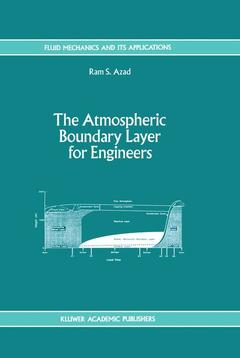The Atmospheric Boundary Layer for Engineers, Softcover reprint of the original 1st ed. 1993 Fluid Mechanics and Its Applications Series, Vol. 17
Langue : Anglais
Coordonnateur : Azad R. S.

While I was participating in the IUTAM Symposium on Structure of Turbulence and Drag Reduction in Zurich, Switzerland, in 1989, I was approached by Prof. Dr. Themistocles Dracos to give a course oflectures on the Atmospheric Boundary Layer during my sabbatical leave at Eidgenossische Technische Hochschule (ETH) Zurich - Hoenggerberg in 1991. His reason for the suggestion was the growing interest in the environment and its dynamics created by flow in the Atmospheric Boundary Layer. I have been teaching boundary layer to undergraduate and graduate students for more than twenty five years, so I agreed to give a series of lectures on boundary layer of the atmosphere. From the start I thought very seriously about the problem and consulted all the published works in English on the Atmospheric Boundary Layer (ABL). First consider the topography of the Earth which has oceans calm and turbulent, mountain ranges of height up to 9 km, lands of variable height with forests, food growing vegetable and deserts. The shape of the Earth is nearly spherical except at the north and south poles. Sun supplies the energy to drive circulation of air around the Earth's atmosphere which for all practical purposes occupies the region up to about 10 to 11 km. This brief scenerio of Earth's topography reveals the complexity of flow very close to the Earth's surface that is hardly flat except at the oceans' surface which consists of about 70% of the total Earth's surface.
1. General Description of Atmospheric Boundary Layer.- 1.1 Preliminary.- 1.2 Definition and Significance of the Atmospheric Boundary Layer.- 1.3 The Coriolis Force.- 1.4 Thermal Conditions in Atmosphere.- 1.5 Nature of Flow.- 1.6 Boundary Layer Structure.- 1.7 Micrometeorology.- 2. Thermodynamics of the Atmospheric Boundary Layer.- 2.1 Physical Variables.- 2.2 The Equation of State.- 2.3 Work done by an Expanding Gas.- 2.4 First Law of Thermodynamics.- 2.5 Latent Heats.- 2.6 Adiabatic Processes.- 2.7 Hydrostatic Equilibrium.- 2.8 Moist Air in Atmosphere.- 2.9 Vertical Stability and Convection.- 2.10 The Second Law of Thermodynamics.- 3. Kinematics of Fluid Motion.- 3.1 Equation of Continuity.- 3.2 Acceleration Field of Moving Fluid.- 3.3 Dilatation or Expansion.- 3.4 Reynolds’ Transport Theorem.- 3.5 Dynamic State of Fluid Motion.- 3.6 The Stress Tensor.- 3.7 The Rate of Deformation Tensor.- 3.8 Relationship between $${\hat P_{ik}}$$ and vik.- 3.9 Pik = - P ?ik$${\hat P_{ik}}$$.- 4. Equations Describing Turbulent Motion in the Boundary Layer of the Atmosphere.- 4.1 Equations of Fluid Motion.- 4.2 Momentum Equation in Noninertial Frame of Coordinate System.- 4.3 The Vorticity Equation.- 4.4 The Pressure Equation.- 4.5 Heat Conduction in Fluids.- 4.6 Conservation of Moisture.- 4.7 Turbulence.- 4.8 Equations Governing The Mean Turbulent Field.- 4.9 Equations for Second Moments of Fluctuating Quantities in Turbulent Field.- 5. Dimensional Analysts and Similarity.- 5.1 Introduction.- 5.2 Dimensional Formulae.- 5.3 Nature of the Functional Relations Between Physical Quantities.- 5.4 Procedure for Obtaining a Complete Set of Dimensionless Parameters.- 5.5 Classification of Self-Similarity Solutions.- 5.6 Application of Similarity.- 6. Basics of Usual Turbulent Boundarylayer; Neutrally Stratified Atmospheric Boundary Layer.- 6.1 Introduction.- 6.2 The Reynolds Stress Tensor and Turbulent Heat Flux Density near a Wall.- 6.3 Mean Velocity Profile in Close Proximity to a Rigid Wall.- 6.4 Viscous Sublayer and Logarithmic Boundary Layer in Flow Close to a Smooth Wall.- 6.5 Flow Along a Rough Wall. Roughness Parameter and Displacement Height.- 6.6 Turbulent Boundary Layer on a Flat Plate.- 6.7 Distribution of Concentration of a Passive Admixture Close to a Wall; Mass-and Heat-Transfer in a Turbulent Boundary Layer.- 6.8 General Perception of Viscosity and Thermal Diffusivity.- 6.9 Further Implications of Richardson Number.- 6.10 Use of Semiempirical Equations for the Description of Turbulence in the Planetary Boundary Layer of the Atmosphere.- 7. the Atmospheric Surface Layer.- 7.1 The Atmospheric Surface Layer Modelled by Thermally Stratified Turbulent Boundary Layer.- 7.2 Use of Dimensional Methods to Turbulence in a Stratified Medium.- 7.3 The Structure of the Universal Functions Characterizing Turbulence in a Stratified Medium.- 7.4 Extended Examination of the Universal Functions; Interpolation Formulae and Semiempirical Formulae.- 7.5 General Similarity Hypothesis for a Turbulent Stratified Boundary Layer and its use in Turbulent Fluctuations.- 7.6 Comparison of the Theoretical Results with Experimental Observations.- 7.7 Measurement Techniques for Turbulent Fluxes of Momentum, Heat, and Water Vapour.- 7.8 Acquisition of Turbulent Fluxes from Data on Profiles of Meteorological Variables.- 7.9 Behaviour of Fluctuations of Wind Velocity and Temperature in the Atmospheric Surface Layer.- References.
Date de parution : 10-2012
Ouvrage de 574 p.
16x24 cm
Thèmes de The Atmospheric Boundary Layer for Engineers :
Mots-clés :
atmosphere; dynamics; material; thermodynamics; turbulent flow
© 2024 LAVOISIER S.A.S.



